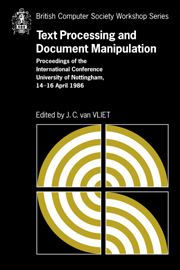 Text Processing and Document Manipulation
Text Processing and Document Manipulation Published online by Cambridge University Press: 05 May 2010
ABSTRACT
The use of a multi-task system seems to open up new perspectives in document preparation. This paper presents such an approach, bringing together the wide possibilities of old markup techniques with the convenience of recently appeared interactive systems. It requires a very clear separation between a document's content and its formatting specification. Furthermore the latter can be favourably expressed with a descriptive formalism based on the document's logical structure.
Introduction
The subject matter of this paper stems from ideas developed in the context of a research contribution made in Lausanne on a document preparation project. The initial goal to produce technical reports has been broadened to solve more general document preparation problems (flexibility, modularity).
As interactive editing systems that include sophisticated typographical features become more fashionable, one might expect traditional formatting techniques to give way. The fact that this is not really the case is due to the advantages and shortcomings inherent in either approach: fast viewing and nice man-machine interface on the WYSIWYG systems, highest typographical quality and greater portability of documents through a variety of textprocessing software on the markup based textfile formatters.
Attempting to combine the good sides of both above mentioned approaches entails several requirements. First, the formatting process needs a flexible parametrisation that provides descriptive formatting specification, clearly separated from the document's content. This approach should offer more flexibility and guarantee portability of a document to several systems with different printing devices. Second, a multi-tasking environment should permit to blend user-comfort with the high typographic quality realized by sophisticated formatting functions.
To save this book to your Kindle, first ensure [email protected] is added to your Approved Personal Document E-mail List under your Personal Document Settings on the Manage Your Content and Devices page of your Amazon account. Then enter the ‘name’ part of your Kindle email address below. Find out more about saving to your Kindle.
Note you can select to save to either the @free.kindle.com or @kindle.com variations. ‘@free.kindle.com’ emails are free but can only be saved to your device when it is connected to wi-fi. ‘@kindle.com’ emails can be delivered even when you are not connected to wi-fi, but note that service fees apply.
Find out more about the Kindle Personal Document Service.
To save content items to your account, please confirm that you agree to abide by our usage policies. If this is the first time you use this feature, you will be asked to authorise Cambridge Core to connect with your account. Find out more about saving content to Dropbox.
To save content items to your account, please confirm that you agree to abide by our usage policies. If this is the first time you use this feature, you will be asked to authorise Cambridge Core to connect with your account. Find out more about saving content to Google Drive.